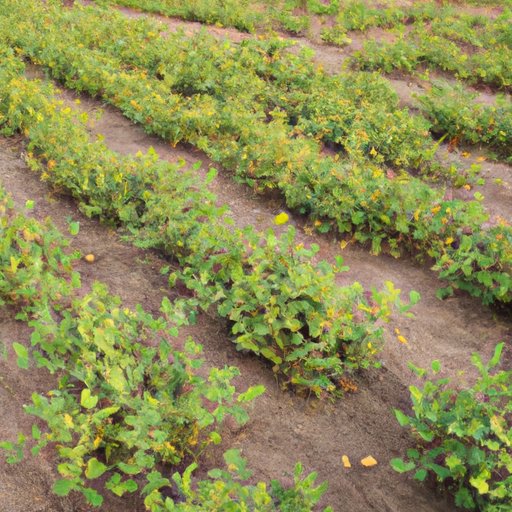Introduction
Do you love peanuts and wish you could grow your own? Growing peanuts is easier than you may think, and it’s a great way to enjoy home-grown snacks. In this article, we will explore the ins and outs of growing peanuts, from creating the ideal soil and climate conditions to harvesting and storing your fresh peanuts. Let’s get started!
Starting Your Own Peanut Patch: A Step-by-Step Guide
The first step in growing peanuts is to choose a location for your peanut patch. Peanuts need full sun and well-draining soil, so choose a spot that gets at least 6-8 hours of direct sunlight each day and has soil that is loose and crumbly. Next, prepare your soil by removing rocks, weeds, and other debris and loosening the soil to a depth of at least 8 inches.
Once your soil is prepared, it’s time to plant your peanuts. Plant your peanuts in rows, spacing the seeds about 4-6 inches apart and planting them about 2 inches deep. Cover the seeds with soil and water them gently.
The Best Soil and Climate Conditions for Growing Peanuts
Peanuts grow best in loose, well-draining soil with a pH between 5.8 and 6.2. The soil should be rich in nutrients and have good drainage to prevent waterlogging. Sandy loam soil is ideal for growing peanuts because it provides good drainage while retaining moisture and nutrients.
When it comes to climate conditions, peanuts thrive in warm, humid weather. The ideal temperature for growing peanuts is between 70 and 90 degrees Fahrenheit, with temperatures below 60 degrees Fahrenheit being harmful to the plants. If you live in a region with cooler temperatures, you can still grow peanuts by using a greenhouse or covering the plants with plastic sheeting to create a warm and humid environment.
Choosing the Right Peanut Varieties to Grow for Your Climate
When selecting peanut varieties to grow in your garden, it’s important to consider your climate and the length of your growing season. Choose peanut varieties that are adapted to your specific region and climate conditions. You can find this information on the seed package or by consulting with your local gardening expert.
Some popular peanut varieties include Virginia peanuts, Valencia peanuts, and Spanish peanuts. Virginia peanuts are known for their large size and are often used for roasting. Valencia peanuts have a sweet taste and are often used for peanut butter. Spanish peanuts are known for their crunchy texture and are often used for making peanut brittle.
How to Plant and Maintain Peanut Seeds in Your Garden
Once you have selected your peanut seeds and planted them in your garden, it’s important to provide them with proper care and maintenance. Water your peanut plants regularly, making sure they receive at least 1 inch of water per week. If your area is experiencing a dry spell, you may need to water your plants more frequently.
Fertilize your peanut plants with a balanced, slow-release fertilizer to help promote healthy growth and development. Prune your plants regularly to remove dead or diseased leaves and to promote better airflow through the plant. If you notice any signs of disease or pest infestation, take action immediately to prevent the problem from spreading.
The Importance of Watering, Fertilizing, and Pruning Your Peanut Plants
Proper watering, fertilizing, and pruning practices are essential for growing healthy peanut plants. Over-watering can lead to root rot, while under-watering can cause the peanut plants to wilt and die. Fertilizing your plants on a regular basis can help promote healthy growth and improve the quality of your peanuts. Pruning your plants can help prevent disease and promote better airflow through the plant.
Protect your Peanut Crop from Disease and Pests
Common peanut plant diseases include leaf spot, early leaf spot, and stem rot. To prevent these diseases, avoid overhead watering and keep your plants well-pruned. If you notice any signs of disease, remove the diseased parts of the plant immediately and treat your plant with a fungicide.
Common pests that can affect peanut plants include aphids, spider mites, and cutworms. To prevent these pests, keep your plants well-pruned and use a natural insecticide if necessary.
Harvesting and Storing Your Fresh Peanuts for Year-Round Use
Peanuts are ready to harvest when the leaves and stems turn yellow, about 120 days after planting. To harvest your peanuts, pull up the entire peanut plant and shake off the soil. Hang the plants in a dry, well-ventilated area for about 2-3 weeks to allow the peanuts to dry.
Once your peanuts are dry, remove them from the plant and remove the shells. Store your shelled peanuts in a cool, dry place in an airtight container, where they can be enjoyed year-round.
Conclusion
Growing your own peanuts is a fun and rewarding experience. By following the steps outlined in this article, you can create the ideal soil and climate conditions for growing healthy peanut plants. Remember to choose the right peanut varieties for your climate, provide your plants with proper care and maintenance, and protect your plants from disease and pests.
